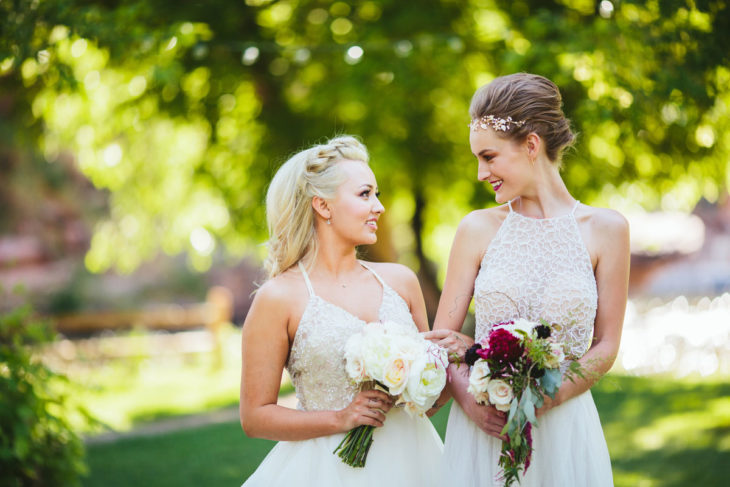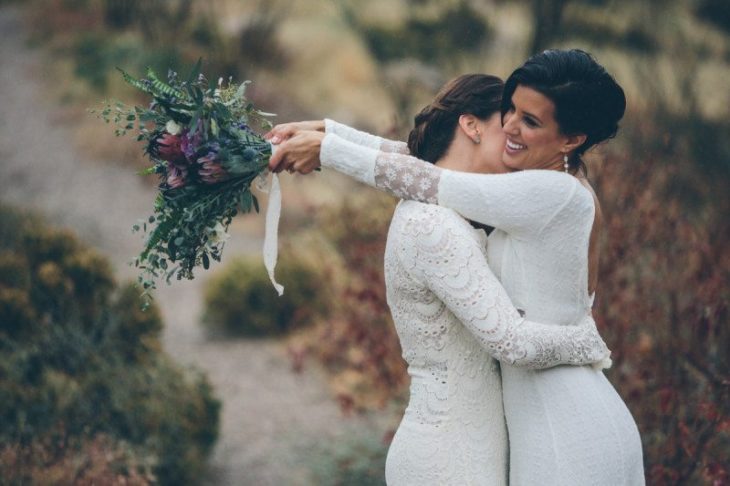In my mid-twenties, I came out as a lesbian. But the hardest part wasn’t even coming out: it was realizing my wedding would be different and therefore I was different. It took me a few years to come to terms with the fact that my wedding wouldn’t have a groom or any of the other stuff that goes along with heterosexual weddings.
A few months ago, my girlfriend of three years proposed. A couple of weeks after we got engaged, Chriss told me she was thinking about converting to Judaism. So as we started planning our wedding, we began attending synagogue together and Chriss enrolled in an Introduction to Judaism class. When we became full-fledged members of our synagogue and reserved the chapel for our wedding it dawned on me: I have no idea what a lesbian Jewish wedding would look like.

Source: Harvey’s Point Weddings
It’s not just how the ceremony will look: we need to figure out the dresses and bridal shower, too. Once Chriss popped the question and we each put a ring on it, my friends starting asking me “Is one of you going to where a suit?”
“Oh, no!” I would exclaim. “We both are going to wear dresses.”
I’m more drawn to a tea-length dress with minimal poof, while Chriss wouldn’t mind a floor-length gown with a train. Recently, a New York Times article wrote about the lesbian outfit dilemma in an article titled “But Now, What to Wear?” and I realized this was slightly more complicated that what pretty white dress we would each don. The article brought up some things I didn’t consider, like as clashing and one-upping each other. One couple, in which both women wore dresses, used one of their sisters as a “go-between” to make sure their dresses didn’t clash. Eek! What if I choose a champagne color and Chriss chooses bright white? What if she wears a simple slip-like dress and I strut out looking like Cinderella? Style and color will be things we’ll have to consider when we each go shopping for our wedding dresses, separately.
We also have to consider the wedding shower. Do we each have a shower, or have a joint one? Last year, couple friends of ours had a joint bridal shower, and it seemed to work out well. They got to open their gifts together and enjoy each other’s friends and family. The idea that this is a celebration that can be shared really appeals to us. We’re lucky in that our friends know each other, my parents adore her, and we could have a bigger party without too much fuss.
But the main event, of course, will be our wedding ceremony. Lucky for us, my Uncle Phil accepted our offer to officiate our wedding, so we are very lucky that we don’t have to find a clergy member to marry us. Reform rabbis have been performing same-sex marriages openly for years and more recently, conservative rabbis and cantors have been allowed to perform them. But it can still be a challenge even if a clergy member performs same-sex ceremonies, he or she may not be okay with performing one for an interfaith couple. Uncle Phil, on the other hand, has performed same-sex weddings, and doesn’t have a problem with Chriss not being Jewish (yet). As long as we agree to live Jewishly, he will perform the ceremony.

Source: Offbeat Bride
Jewish wedding ceremonies have traditional liturgy that is used and vows are optional. One of the prayers uttered is regarding sexual propriety. A family friend emailed me some revised liturgy that was compiled by a gay cantor. His rewording has a version for two brides or two grooms. Another source, a website called ritualwell.org has a play-by-play for a traditional Jewish lesbian wedding. When I found it I had an “Aha” moment, and felt relieved that it wouldn’t so difficult to find something that Chriss, Phil, and I can work with. One thing this particular couple did was modify the language in the ring ceremony from “By this ring you are consecrated to me as my husband, in accordance with the traditions of Moses and Israel” to “Behold, you are united with me in holiness.”
Another text dilemma I’ve thought about is the kettubah, the wedding contract. Kettubot (plural for kettubah) have a variety of texts to choose from, from personalized, to Orthodox, egalitarian, and feminist. In her book The New Jewish Wedding, Anita Diamant gives examples of a variety of kettubot, again giving me comfort that Chriss and I won’t have a problem finding one that is right for us. While none of the examples in her book are for same-sex couples, it’s easy to see how her egalitarian example could be modified to say “the brides” or the “couple,” rather than “the groom and bride.”
When I first started thinking about our lesbian Jewish wedding, I felt overwhelmed, and clueless. But as I continue to read more books, talk to more lesbian friends, and consult Jewish websites, I’m starting to feel really confident that Chriss and I can have an amazing, spiritual, and memorable wedding. I’m thrilled knowing that I can teach Chriss about Jewish tradition in a way that is inclusive, rather than exclusive, and that she is a welcomed part of my life, traditions, and faith.

Source: Steph Grant Photography
Original by
